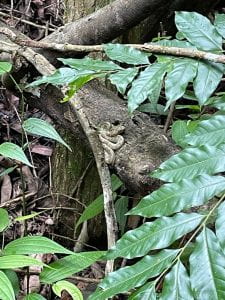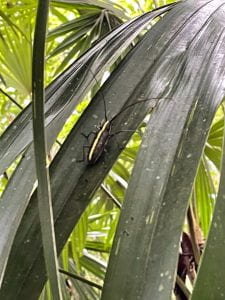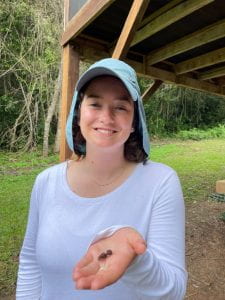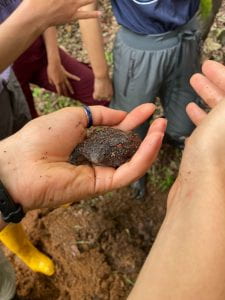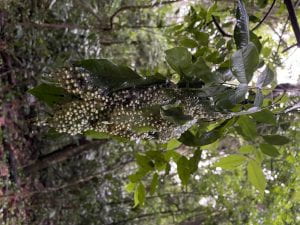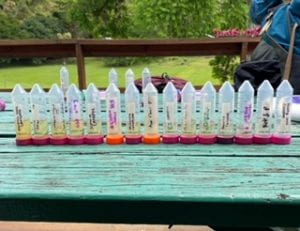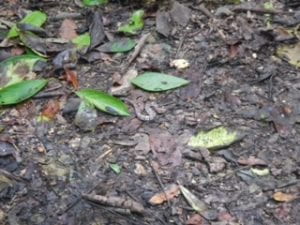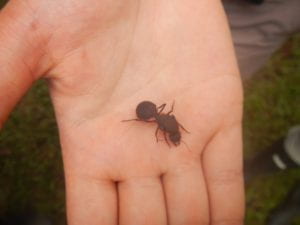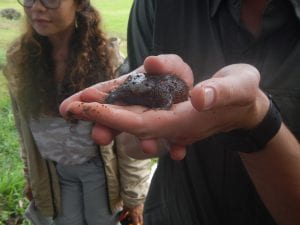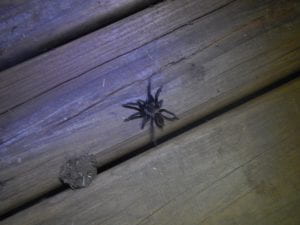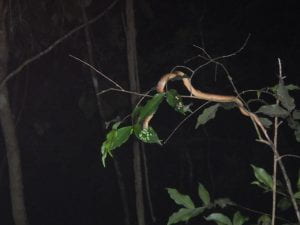It’s pitch black outside. You look up, and the stars illuminate the tree silhouettes and snake-shaped vines surrounding you. You flick on your headlamp, scan the ground, and see thousands of tiny, glimmering emeralds. Dr. Solomon tells you they are spider eyes, and the realization hits you: It’s a spider’s world, and you’re living in it. My new favorite hobby is night hiking.
Today, we saved the hiking for the evening and spent the morning learning about what really goes on at Las Cuevas Research Station, the site we are staying at as we study the rainforest. It is owned by Friends for Conservation and Development, a non-profit centered around environmental protection, but their work extends far beyond a single initiative. They started as a group of passionate teenagers who cherished the environment and wanted to protect it, and bloomed into an organization that hires rangers (forest monitoring), runs research stations, restores endangered species (including macaws, jaguars, game species, etc), maintains and protects cultural richness (ex. They protect Mayan remains in the caves), and help local communities. Their work and growth as a grassroots group is absolutely inspirational, and I now have my heart set on working as a ranger for them. I just need to practice carrying 80-lb weight bags places and train my knees for the steep inclines.
The FCD focuses the majority of its time and resources on protecting scarlet macaws. It is estimated that there are only 350 individuals in Belize due to extreme poaching. To protect chicks from poaching, FCD members extract chicks from the nest, raise them, and release them once they are more capable of defending themselves. We’re incredibly lucky to be staying in the only region of the Chiquibul Forest where they are found, and we see a couple fly overhead almost every day.

(Scarlet Macaw Feather – 05/20/25)
After lunch, we went on a hunt for leaf-cutter ant colonies–more specifically, the prized fungal gardens inside. I mentioned in an earlier blog post that leaf cutters are little gardeners who cultivate this fungus, which they eat by feeding it leaves and other materials. We wanted to see their rich harvests for ourselves.

(Fungal Garden with Queen Ant – 05/20/25)
In our search for ant hills, we set out to find both a young and an older, more mature colony. We examined how colony structures differed and changed with age. Right by the cabin, out in the open field, we saw a teeny ant hill, and Dr. Solomon started digging around the nest on the spot. New colonies are often found in open spaces or edge habitats (between the rainforest and open clearings) because the Queen ant needs to find cover asap to avoid predation, and these spaces are the most accessible. New colonies are started when a preexisting colony produces another queen, and this queen takes a chunk of fungus with her and flies high into the air to mate with a male. Once she’s fertilized, she’s set to lay eggs for the rest of her life. (She’s ___, meaning she only needs to mate once and can store the rest for the future). From there, she burrows into a new spot on the ground and starts cranking out eggs. The workers that hatch will continue digging new chambers until the hill is giant.
We walked down the trail to a massive ant mound the size of a shed aboveground that was fully mature and could have been anywhere from 15-25 years old. Underground, it easily could have been 3x more voluminous. We saw a ton of tunnels burrowing down from the surface and learned that the whole colony breathes as one unit; the tubes take in oxygen and exhale CO2.
Then, Dr. Solomon popped the question, “So do we want to rile up the ants first or start digging first? Either way, they’re going to come out.” Rile them up? These guys are no joke – they can reach the size of a thumb (from what I’ve seen) and have zinc-lined, vibrating saw-like pinchers that can draw serious blood. We all looked around at each other with big eyes, and Sam, our ant expert, volunteered to be our first digger. 30 seconds later, Sam had a battle wound (bite), and these massive guys started streaming out like a broken fire hydrant. We all started tap dancing to flick them off of our rubber boots, but with their intense pinchers, they latched on and began to chew through the rubber. In the meantime, Dr. Solomon bravely spooned some exposed fungus out of the colony. Fungus acquired, mission accomplished, and lesson learned – don’t disturb shed-sized ant hills.
IMG_7296 (1) (Ants Swarming – 05/20/25)
After a dinner watching the sunset from our cabin deck, we embarked on a night hike to see more of the incredible creatures that call this jungle home. We breathed slowly, listening to the sounds of the jungle at night. Our our way back, we had the unexpected pleasure of seeing Belize’s National Flower, the tiny black orchid (an epiphyte!), sitting on the tree out front of our cabin. Feeling fortunate and at peace, we ended the day lying on top of the picnic and gazing up at the stars, making shapes with the stars. There is so much life out there to cherish and discover.

(Black Orchid: Belize’s National Flower – 05/20/25)
Peace & Love,
Lily 🙂


